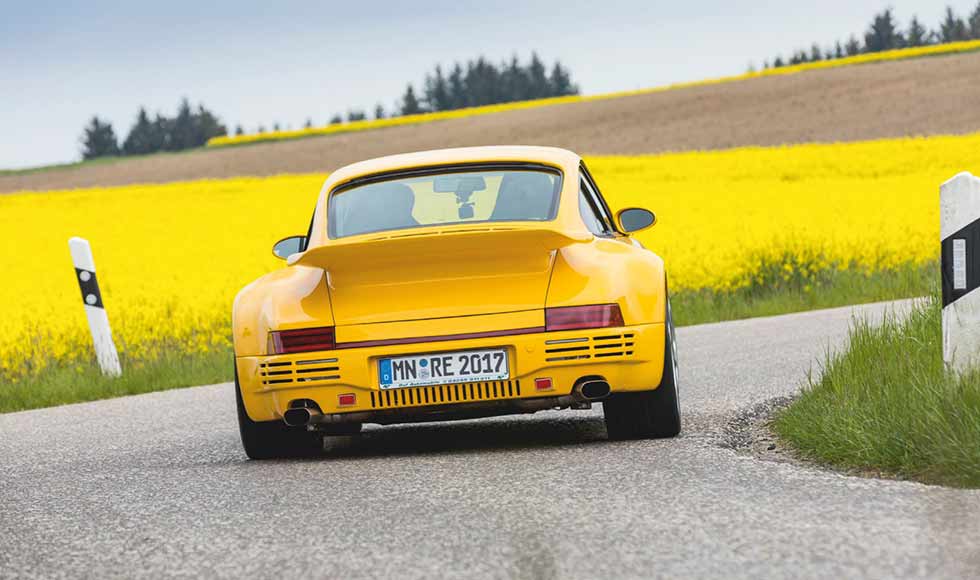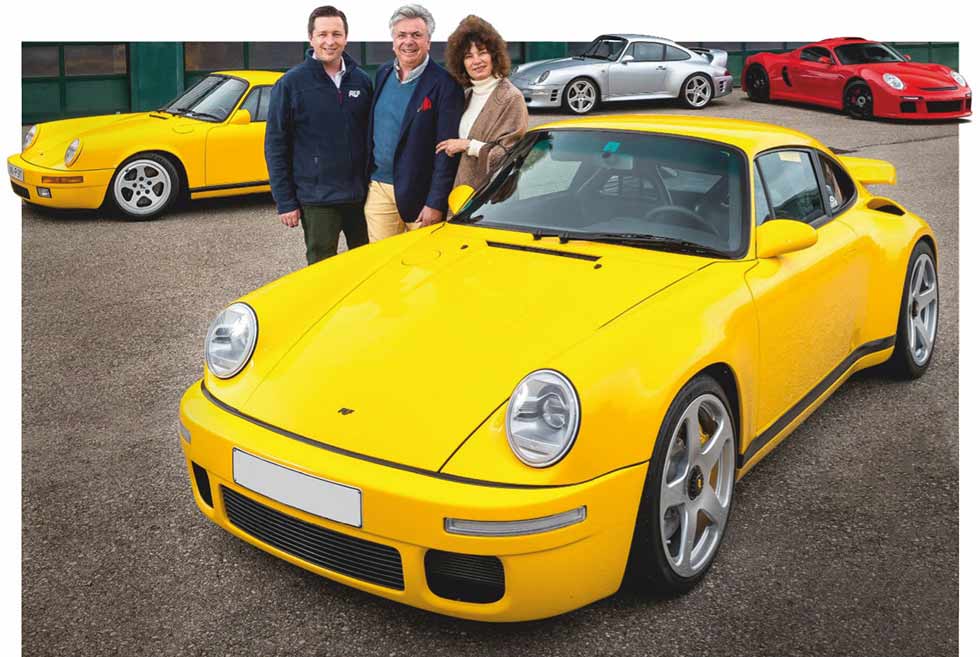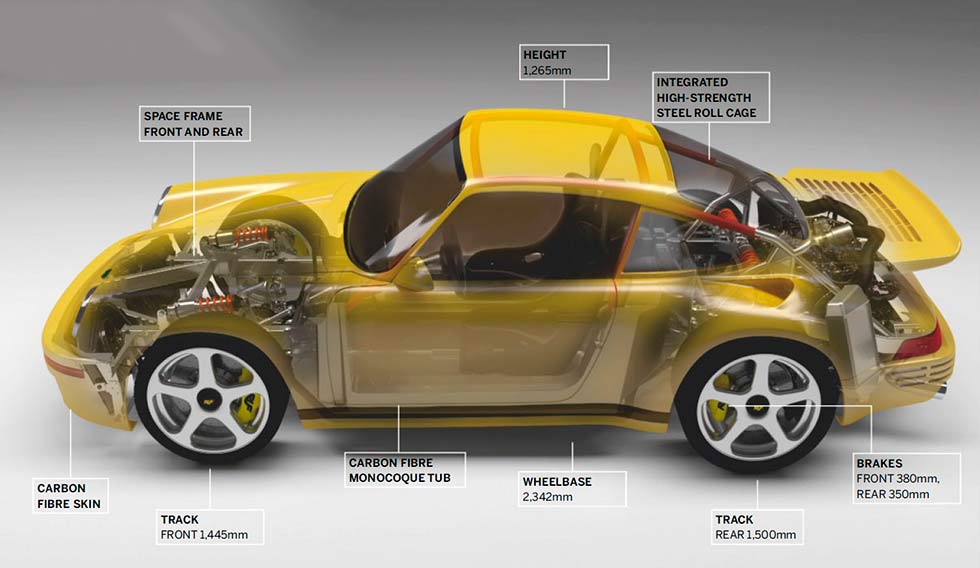
80 years of RUF: CTR Anniversary driven It’s our first drive of the CTR Anniversary. Does RUF’s modern-day Yellowbird live up to the legend of its ancestor? RUF’s CTR Anniversary might be a nod to the past but it also offers a glimpse into the future of engineering at Pfaffenhausen. Drive-My is one of the first to test the 21st-century Yellowbird. Written by Lee Sibley. Photography by Daniel Pullen.
The greatest 80 years of RUF: CTR Anniversary first drive
“The Yellowbird is a car that made us internationally renowned from one day to another. We were the world’s fastest car – all the big companies were slower. No matter if it was 20 years ago, ten years ago or just yesterday, everybody talks about this car.” These are the words of Marcel Ruf, who talks with passion and pride when I ask him to describe what the RUF CTR of 1987 did for his father’s company.

It was that 3.2 Carrera-based ‘Yellowbird’ which put RUF Automobile on the map. A real-life David versus Goliath moment, it was faster than Ferrari’s F40 and Porsche’s 959, inspiring an entire generation of automotive fanatic. Those three letters responsible for building it became an alluring brand synonymous with engineering precision and purity henceforth.
“If, as an avid 911 enthusiast, you were to start with a blank sheet of paper and then create your ultimate sports car, this would be the outcome”
We’re here on Rufplatz to celebrate 80 years of a company which has been integral to the culture surrounding the 911, a sports car we all – RUF included – admire greatly. RUF has always found a way to improve on Porsche’s recipe, consistently evolving the 911 years ahead of Zuffenhausen. It led to RUF becoming a certified manufacturer in its own right by the German authorities in 1981, and since then we’ve been on the road to this very moment, a dream Alois Ruf Jr has harvested for decades: to build a complete sports car from scratch. That car is the new RUF CTR.

Revealed in 2017 – 30 years since the original – the latest CTR has undergone further testing, tweaks and even a name change. The CTR Anniversary, as it is now known, is at last approaching the finished article, and is a fitting way for this family-run business to celebrate its 80th birthday.
Putting the festivities to one side, this new CTR is arguably the most important RUF creation in years. Times have changed, and now there’s much stiffer competition for ultra high-end, Porsche-inspired craftwork, most notably from a well-known company some 5,000-miles away in north hollywood. Looking more inwardly too, the fact this is the first RUF to be built completely from scratch carries a significant cost. Company sources tell me it could be between €12 to 15 million to develop the CTR, all of the investment coming directly from RUF itself. It’s a statement of confidence to say the least, the carbon fibre monocoque at its centre forming, we are told, the basis of RUF cars of the future as well as now. On paper the CTR Anniversary’s credentials (we’ll come to those later) have well and truly resonated with the uber wealthy, so much so that all 30 cars of the initial build run were sold within a week. I say initial build run, as off-the-bat demand for the CTR Anniversary caught out not only RUF itself, but owners of the first CTR, too, who simply didn’t react quick enough to bag the latest example. “We felt it was important that those owners of the original CTR were given the opportunity to have an Anniversary, so we spoke with the 30 buyers of the new car and asked how they felt about us increasing production to 50 cars to solve the problem. Thankfully they gave their blessing, so we were able to offer the extra 20 spaces only to those who had a CTR1,” Marcel Ruf explains. A potential sticking point dealt with efficiently and calmly – how typically German.
Production of the CTR Anniversary is set to run until 2022 (by which time the company will also have started building its new, naturally aspirated SCR) with deliveries beginning later this year. A handful are very near to completion, these being assembled by hand on the factory floor during our visit. however, sitting outside and resplendent in the house colour of yellow, there’s an example ready for the road – and we’re going to be driving it.
The new CTR is mesmerising to look at. Its carbon fibre body, housing that lightweight monocoque and front/rear space frame, is an art form. It’s modelled on the original CTR, of that there is no doubt, yet “it’s as if the Anniversary has been to the gym”, so Marcel himself says. he’s right, the CTR possessing the perfect blend of modern muscularity and timeless, delicate swathes of a classic 911-inspired silhouette. I could honestly stand and absorb its lines for days.
This example is a prototype, and nearby assembly of an early production car offers opportunity for comparison. The production car has lost the superfluous but admittedly entertaining rear torsion bar caps, and its front bumper has clearly been reprofiled to incorporate larger and neater side air vents. The front turn signals are thinner, and the wheels now have a cut-out down the middle of each spoke, too. Inside, the dashboard is different, the one in the prototype lifted directly from an air-cooled 911 – the production version is 3D printed, along with up to 20 per cent of overall parts. The production car will also get customary lollipop seats. An external oil filler remains, as does an off-center fuel filler through the frunk – RUF says it’s more practical.
Interestingly, the only visible components of the CTR Anniversary taken directly from a Porsche are the front and rear screens, side windows and frames. They’re from a 993, but even the rear windows have been modified, the frames sloping inwards at the back to allow for subtle intakes feeding air directly into the CTR’s dry-sumped and highly modified Mezger engine. Gaping holes in the bodywork aft of the rear arch, their profile taken directly from the original CTR, ply two intercoolers with cold air, one used for each turbocharger. Because it’s a water-cooled unit – the type used on a 997 Turbo – there’s no need for any other air inlets, the new CTR’s ventilation instead used to dissipate heat. This is done via slits in the rear bumper and backwards-facing vents on top of the whaletail, reversed from those on the first (and air-cooled) Yellowbird.
Its chassis is cutting-edge in the realms of the 911, boasting double-wishbone suspension arms and horizontally mounted dampers in pushrod configuration. It is the ideal set-up. The CTR is, of course, rear-wheel drive with a limited-slip differential, braked by ceramic discs and six-pot calipers with up front, four-pot at the rear. ABS and traction control are the only help from a computer.
Because this is a prototype, I won’t be testing for an official 0-62mph time or top speed, which is a shame as the Autobahn is just minutes away, but it will give a very strong indication as to what the 50 lucky owners have signed themselves up for. It’s probably a good thing: I’m handed the keys, and as I lower myself into the car I’m served a pat on the back and a jovial note of caution. “have fun, and remember you’ve got one million euros under your ass,” a voice says before the driver’s door is slammed shut behind me with the familiar ‘clink’ of a classic 911 latch. And with that, the 21st-century Yellowbird is all mine for the afternoon.
This might be a completely new and original sports car, yet it still feels like home. Looking out of the upright front screen, familiar front fenders protrude forwards; it’s small and cosy, the pillars still thin despite housing RUF’s customary integrated roll cage. All-round vision remains excellent.
However I’m sitting much lower and, in a further positive move, the awkward offset of a classic 911’s pedals are long gone.
Firing up the car, its noise is pure Mezger, its tone more fierce, its sound turned up a couple of notches. Otherwise the clutch is the only real sign of the CTR’s crazy power figure: it’s heavy to depress, on par with a 996 GT2, but I like its mechanical feel. Surprisingly for a lightweight car with 710hp, it’s fairly docile at slow speeds. The steering is light, assisted by an electric pump, and forms the biggest giveaway as to the era this Yellowbird is really from. I slip out of town and, with the engine warmed, decide to let rip. Oh. My. God.
There’s a split-second delay before the car surges forward like an early Turbo on full boost. Only the CTR itself hasn’t hit boost yet. By two-and-a-half grand, to a cacophony of whooshing and whistling, there’s an almighty wallop from behind as those KKK turbochargers kick in and the CTR engages what feels like a velocity reserved for fighter jets. Just shy of 8,000rpm arrives in an instant; the needle of the boost gauge, which has replaced the dash clock, flings hilariously from 0 to 1.4-bar like the hammer of a triggered mouse trap – it’s that fast.
I’ve never experienced such torque in a car before, yet it’s not as kamikaze as Porsche’s all-or-nothing GT2 RS, the CTR more sophisticated in the way it delivers its power. It’s brutal, for sure, but it builds nicely if you’re brave enough to keep your foot in. Do so and you’ll be rewarded, for the CTR is comfortable at big speeds, this being a car RUF says was, like its predecessors, built with the Autobahn in mind.
Most impressive though is the CTR’s ability to carry speed so effortlessly, directly manifested by its feather-light mass and brilliant chassis. At just 1,200kg it weighs less than a Renault Clio, its extremely low centre of gravity keeping it agile when the road begins to bend. Its chassis, unfazed by these remarkably smooth surfaces, means the car does an excellent job of ensuring directional changes do little to deter pace. Transitions are smooth, with little in the way of observable pitch and roll, the CTR staying impressively taut in its effort to maintain grip across the entirety of its footprint. A tight right-hander demonstrates this so wonderfully: with only a dab of the carbon ceramic brakes before corner entry, the CTR’s nose stays flat as it dives for the apex, and I’m then completely astonished at how ridiculously early I can get back on the gas. Pulling away fast from the corner, I can’t help but laugh my head off – the whole thing just feels downright naughty, probably because I’m in a car which looks and, to a certain degree, feels like a classic 911, and yet it accomplishes things that you’d never dream of in the real thing.
The CTR’s gearbox, too, is an engineering marvel. Created in partnership with ZF, who also make Porsche transmissions, it’s a seven-speed unit, though unlike those found inside a Porsche 911, seventh isn’t a mere overdrive gear, the CTR’s top speed “in excess of 223mph” achieved by using it. Thanks to the profile of the carbon monocoque’s transmission tunnel, the skinny shifter, akin to that of a 993 RS in appearance, is mounted higher than in any 911 it might take its design cues from. Most importantly its shift is pure harmony, possessing a fluidity and rifle-bolt preciseness not seen outside of a 991 R. It needs to be, too, because when you’ve got a flat six feeding 710hp to the rear wheels you can’t afford to be worrying about getting a gear change wrong.
RUF says there are limited driver aids on this car, “so the driver is challenged to be the boss”. That certainly is the case: it’s an accomplished steer, but it’s absolutely not easy; the CTR will kick if you take the mickey too much. Really, it all adds to the remarkable character of this wonderfully crafted sports car, which helps set it apart from its contemporaries. Today’s sports cars are more powerful and laden with science-bending tech than ever before. There’s a caveat to this numbing assault of big power and groundbreaking gadgetry, and that’s a wavering in connection between car and driver. Somehow though, RUF has managed to buck that trend, building a car as quick and dynamically capable as anything you’ll ever likely drive, which not only upholds that connection, but extends it. If, as an avid 911 enthusiast, you were to start with a blank sheet of paper and then create your ultimate sports car, this would be the outcome. It is quite remarkable. Few cars have ever, or will ever, offer an experience so positively engrossing.
Conscious of my role as a journalist to offer a balanced critique, I spend the entire journey back to Rufplatz trying to find fault with the new CTR, but the task is near impossible. All I can muster is that I’d like the steering to carry a little more weight to it, but really the system is on par with the best 991 GT cars. exasperated, I return the car and give its keys back to Marcel. Remember his resounding appraisal of the first Yellowbird earlier in the day? Part of that quote has deliberately been left out until now.
“It’s our philosophy to have the classical features of that 1987 CTR in a modern car, reinterpreted,” he continued, before turning serious for the only time during our stay. “We feel very, very responsible to fulfil those 50 orders and come up with the perfect car.” he need not have worried. It can’t claim to be the world’s fastest sports car today, but the CTR Anniversary, by our reckoning, could certainly be the greatest.
BELOW its kinetic dynamism and supreme cornering ability make it the ultimate expression of a Porsche 911.
ABOVE Cabin is completely bespoke but has a familiar classic 911 feel to it. Production seats and dash have been tweaked slightly. LEFT Whale tail assumes a familiar appearance to CTR1, its vents reversed to offer better heat dissipation.
FAR RIGHT RUF has concentrated on the details to ensure its CTR is as light as possible. Titanium con rods, for example, are 30% lighter, and one fifth of the CTR’s parts are 3d printed.
TOP RIGHT RUF has partnered with ZF to build its own seven-speed gearbox for the CTR Anniversary. RIGHT Pop-out door handles keep the CTR’s sleek appearance, though its latches use a familiar, classic 911 mechanism.
Model RUF CTR Anniversary
Year 2019
Engine Capacity 3,600cc
Compression ratio 9.0:1
Maximum power 710hp @ 6,750rpm / DIN net
Maximum torque 880Nm @ 2,750-4,000rpm / DIN nett
Transmission Seven-speed manual
Suspension
Front Double-wishbone suspension with horizontal dampers in pushrod configuration (dampers mounted longitudinally)
Rear Double-wishbone suspension with horizontal dampers in pushrod configuration (dampers mounted transversely)
Wheels & tyres
Front 8.5×19-inch forged alloy centre-locking wheels; 245/35/ZR19 Michelin Cup 2 tyres
Rear 11×19-inch forged alloy centrelocking wheels; 305/30/ZR19 Michelin Cup 2 tyres
Dimensions
Length 4,207mm
Width 1,818mm
Weight 1,200kg
Performance
0-62mph (0-100kmh) 3.5 seconds (claimed)
Top speed 224mph (claimed)
Opening
Technicians at RUF Automobile put the finishing touches to the wiring of a production CTR Anniversary, scheduled for delivery later this year. A €12 million investment, the new CTR seeks to emulate the illustrious original of some 30 years ago, a large poster of which hangs proudly on the wall overlooking the factory floor.

Technicians at RUF Automobile
CTR ANNIVERSARY UNDER THE SKIN
key specs and make-up behind RuF’s new Yellowbird







